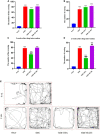Disturbed relationship between glucocorticoid receptor and 5-HT1AR/5-HT2AR in ADHD rats: A correlation study
- PMID: 36699537
- PMCID: PMC9869156
- DOI: 10.3389/fnins.2022.1064369
Disturbed relationship between glucocorticoid receptor and 5-HT1AR/5-HT2AR in ADHD rats: A correlation study
Abstract
Objective: This work is to investigate the alterations of the central 5-hydroxytryptamine (5-HT) system in spontaneously hypertensive rats (SHR) and the correlation with the behaviors of SHR, and to explore the effects of glucocorticoid intervention on the central 5-HT system and SHR behaviors.
Materials and methods: Three weeks old SHR were chosen as the attention-deficit hyperactivity disorder (ADHD) model and treated with glucocorticoid receptor (GR) agonist or inhibitor, whereas Wista Kyoto rats (WKY) were chosen as the normal control group. Open-field test and Làt maze test were used to evaluate the spontaneous activities and non-selective attention. The levels of 5-HT in the extracellular fluid specimens of the prefrontal cortex of rats were analyzed by high-performance liquid chromatography. The expressions of GR, 5-HT1A receptor (5-HT1AR), and 5-HT2A receptor (5-HT2AR) in the prefrontal cortex were analyzed through immunohistochemistry.
Results: Our study demonstrated that the 5-HT level was lower in the prefrontal cortex of SHR compared to that of WKY. The Open-field test and Làt maze test showed that GR agonist (dexamethasone, DEX) intervention ameliorated attention deficit and hyperactive behavior, whereas GR inhibitor (RU486) aggravated the disorders. With DEX, the expression levels of 5-HT and 5-HT2AR in the prefrontal cortex of SHR were significantly higher than those in the control group, whereas the expression level of 5-HT1AR was lower. However, the expression levels of 5-HT and 5-HT2AR were significantly decreased after the intervention with RU486, while the expression level of 5-HT1AR increased. Results showed that glucocorticoid was negatively correlated with 5-HT1AR and positively correlated with 5-HT2AR.
Conclusion: In the prefrontal cortex of ADHD rats, the down-regulation of 5-HT and 5-HT2AR expressions and the up-regulation of 5-HT1AR, compared with WYK rats, suggested a dysfunctional central 5-HT system in ADHD rats. The GR agonist can upregulate the expression of 5-HT and 5-HT2AR and downregulate the expression of 5-HT1AR in the prefrontal cortex of SHR as well as reduce the hyperactivity and attention deficit behavior in SHR, while the opposite was true for the GR inhibitor. It is suggested that the dysfunction of the 5-HT system in ADHD rats is closely related to glucocorticoid receptor activity.
Keywords: 5-HT; 5-HT1A receptor; 5-HT2A receptor; attention deficit hyperactivity disorder; glucocorticoid receptor.
Copyright © 2023 Lin, Huang, Huang, Ke and Chen.
Conflict of interest statement
The authors declare that the research was conducted in the absence of any commercial or financial relationships that could be construed as a potential conflict of interest.
Figures








Similar articles
-
Serotonergic and Adrenergic Neuroreceptor Manipulation Ameliorates Core Symptoms of ADHD through Modulating Dopaminergic Receptors in Spontaneously Hypertensive Rats.Int J Mol Sci. 2024 Feb 15;25(4):2300. doi: 10.3390/ijms25042300. Int J Mol Sci. 2024. PMID: 38396978 Free PMC article.
-
[Effect of glucocorticoid receptor function on the behavior of rats with attention deficit hyperactivity disorder].Zhongguo Dang Dai Er Ke Za Zhi. 2018 Oct;20(10):848-853. doi: 10.7499/j.issn.1008-8830.2018.10.013. Zhongguo Dang Dai Er Ke Za Zhi. 2018. PMID: 30369362 Free PMC article. Chinese.
-
Glucocorticoids/glucocorticoid receptors effect on dopaminergic neurotransmitters in ADHD rats.Brain Res Bull. 2017 May;131:214-220. doi: 10.1016/j.brainresbull.2017.04.013. Epub 2017 Apr 27. Brain Res Bull. 2017. PMID: 28458039
-
Hypodopaminergic and hypernoradrenergic activity in prefrontal cortex slices of an animal model for attention-deficit hyperactivity disorder--the spontaneously hypertensive rat.Behav Brain Res. 2002 Mar 10;130(1-2):191-6. doi: 10.1016/s0166-4328(01)00425-9. Behav Brain Res. 2002. PMID: 11864734 Review.
-
The spontaneously hypertensive-rat as an animal model of ADHD: evidence for impulsive and non-impulsive subpopulations.Neurosci Biobehav Rev. 2003 Nov;27(7):639-51. doi: 10.1016/j.neubiorev.2003.08.007. Neurosci Biobehav Rev. 2003. PMID: 14624808 Review.
Cited by
-
Serotonergic and Adrenergic Neuroreceptor Manipulation Ameliorates Core Symptoms of ADHD through Modulating Dopaminergic Receptors in Spontaneously Hypertensive Rats.Int J Mol Sci. 2024 Feb 15;25(4):2300. doi: 10.3390/ijms25042300. Int J Mol Sci. 2024. PMID: 38396978 Free PMC article.
-
Long-Term Soft-Food Rearing in Young Mice Alters Brain Function and Mood-Related Behavior.Nutrients. 2023 May 20;15(10):2397. doi: 10.3390/nu15102397. Nutrients. 2023. PMID: 37242280 Free PMC article.
References
-
- Angeli E., Korpa T., Johnson E., Apostolakou F., Papassotiriou I., Chrousos G., et al. (2018). Salivary cortisol and alpha-amylase diurnal profiles and stress reactivity in children with attention deficit hyperactivity disorder. Psychoneuroendocrinology 90 174–181. 10.1016/j.psyneuen.2018.02.026 - DOI - PubMed
LinkOut - more resources
Full Text Sources
Research Materials

